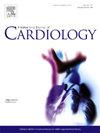The use of supersaturated oxygen therapy in patients with late-presentation anterior ST-segment elevation myocardial infarction
IF 3.2
2区 医学
Q2 CARDIAC & CARDIOVASCULAR SYSTEMS
引用次数: 0
Abstract
Background
Patients with late-presentation anterior ST-elevation myocardial infarction (STEMI) are at increased risk of heart failure and mortality due to greater infarct size and microvascular injury including microvascular obstruction (MVO) and intramyocardial hemorrhage (IMH). Apart from primary percutaneous coronary intervention (PCI), no additional therapies are available for this high-risk group. Supersaturated oxygen therapy (SSO2) is utilized for anterior STEMIs with ischemic times under 6 h and may reduce infarct size. We investigated if SSO2 therapy may provide a clinical benefit for late-presentation anterior STEMI patients.
Methods
SSO2 therapy was administered to 19 late-presentation anterior STEMI patients (12 males (M), 7 females (F); 60 yr.) for 60-min following primary PCI. Patients underwent cardiac MRI (CMR) prior to discharge for evaluation of infarct size, MVO, and IMH. Results were compared to a control group of 31 late-presentation anterior STEMI patients (19 M, 12F; 59 yr.) who received PCI and CMR but not SSO2.
Results
The left anterior descending artery (LAD) was completely occluded in 89 % of SSO2 patients and 77 % of control patients prior to PCI. Final TIMI 3 flow was achieved in 84 % of all patients. Ejection fraction at baseline as well as infarct size, were similar between the two groups. Significantly fewer SSO2 patients had MVO (75 % vs 100 %, p = 0.01) and residual ST-segment elevation following PCI was significantly less in the SSO2 group suggestive of improved microvascular perfusion. Mortality was significantly reduced in the SSO2 group following STEMI compared to control patients (0 % vs 23 %, p = 0.03).
Conclusions
SSO2 can be safely delivered to late-presentation anterior STEMI patients and results in less MVO and less adverse events including all-cause mortality. SSO2 therapy may represent a new treatment for this high-risk patient group.
求助全文
约1分钟内获得全文
求助全文
来源期刊

International journal of cardiology
医学-心血管系统
CiteScore
6.80
自引率
5.70%
发文量
758
审稿时长
44 days
期刊介绍:
The International Journal of Cardiology is devoted to cardiology in the broadest sense. Both basic research and clinical papers can be submitted. The journal serves the interest of both practicing clinicians and researchers.
In addition to original papers, we are launching a range of new manuscript types, including Consensus and Position Papers, Systematic Reviews, Meta-analyses, and Short communications. Case reports are no longer acceptable. Controversial techniques, issues on health policy and social medicine are discussed and serve as useful tools for encouraging debate.
 求助内容:
求助内容: 应助结果提醒方式:
应助结果提醒方式:


